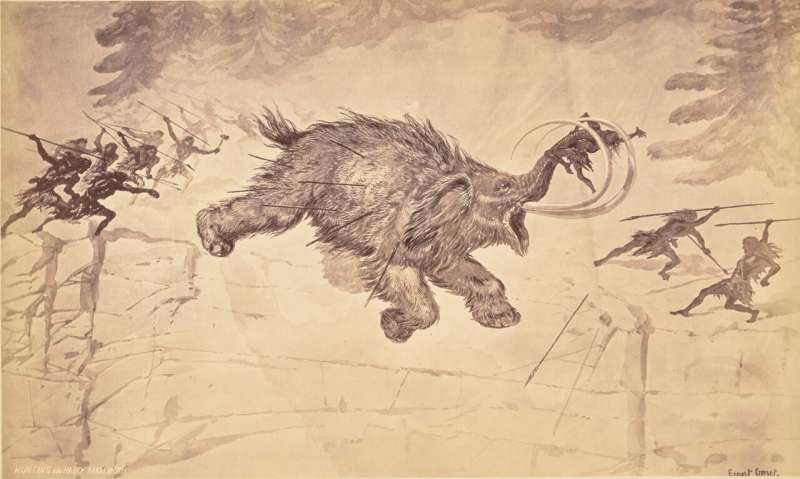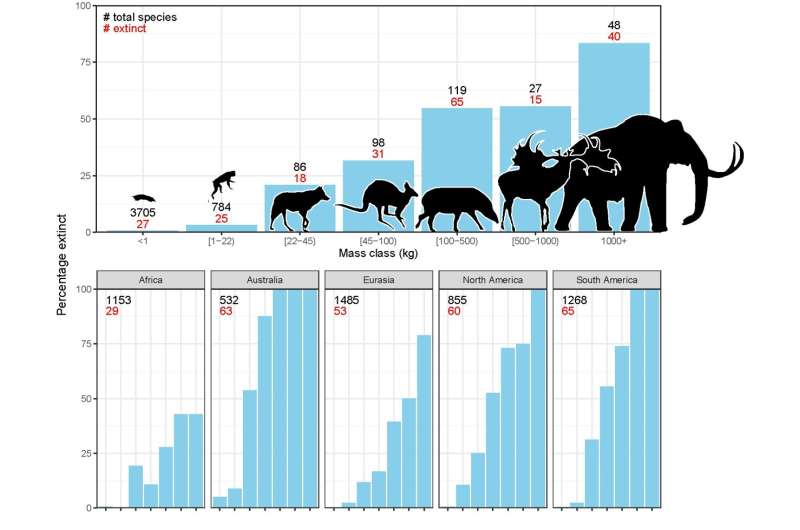This article has been reviewed according to Science X's editorial process and policies. Editors have highlighted the following attributes while ensuring the content's credibility:
fact-checked
peer-reviewed publication
trusted source
proofread
The evidence is mounting: Humans were responsible for the extinction of large mammals

The debate has raged for decades: Was it humans or climate change that led to the extinction of many species of large mammals, birds, and reptiles that have disappeared from Earth over the past 50,000 years?
By "large," we mean animals that weighed at least 45 kilograms—known as megafauna. At least 161 species of mammals were driven to extinction during this period. This number is based on the remains found so far.
The largest of them were hit the hardest—land-dwelling herbivores weighing over a ton, the megaherbivores. Fifty thousand years ago, there were 57 species of megaherbivores. Today, only 11 remain. These remaining 11 species have also seen drastic declines in their populations, but not to the point of complete extinction.
A research group from the Danish National Research Foundation's Center for Ecological Dynamics in a Novel Biosphere (ECONOVO) at Aarhus University now concludes that many of these vanished species were hunted to extinction by humans.
They present this conclusion in a review article invited by and published in the journal Cambridge Prisms: Extinction. A review article synthesizes and analyses existing research within a particular field.
In this case, the researchers from Aarhus University incorporated several research fields, including studies directly related to the extinction of large animals, such as:
- The timing of species extinctions
- The animals' dietary preferences
- Climate and habitat requirements
- Genetic estimates of past population sizes
- Evidence of human hunting
Additionally, they included a wide range of studies from other fields necessary to understand the phenomenon, such as:
- Climate history over the past 1–3 million years
- Vegetation history over the past 1–3 million years
- Evolution and dynamics of fauna over the past 66 million years
- Archaeological data on human expansion and lifestyle, including dietary preferences

Climate change played a lesser role
The dramatic climate changes during the last interglacial and glacial periods (known as the late Pleistocene, from 130,000 to 11,000 years ago) certainly affected populations and distributions of both large and small animals and plants worldwide. However, significant extinctions were observed only among the large animals, particularly the largest ones.
An important observation is that the previous, equally dramatic ice ages and interglacials over the past couple of million years did not cause a selective loss of megafauna. Especially at the beginning of the glacial periods, the new cold and dry conditions caused large-scale extinctions in some regions, such as trees in Europe. However, there were no selective extinctions of large animals.
"The large and very selective loss of megafauna over the last 50,000 years is unique over the past 66 million years. Previous periods of climate change did not lead to large, selective extinctions, which argues against a major role for climate in the megafauna extinctions," says Professor Jens-Christian Svenning. He leads ECONOVO and is the lead author of the article.
He adds, "Another significant pattern that argues against a role for climate is that the recent megafauna extinctions hit just as hard in climatically stable areas as in unstable areas."
Effective hunters and vulnerable giants
Archaeologists have found traps designed for very large animals, and isotope analyses of ancient human bones and protein residues from spear points show that they hunted and ate the largest mammals.
Svenning adds, "Early modern humans were effective hunters of even the largest animal species and clearly had the ability to reduce the populations of large animals. These large animals were and are particularly vulnerable to overexploitation because they have long gestation periods, produce very few offspring at a time, and take many years to reach sexual maturity."
The analysis shows that human hunting of large animals such as mammoths, mastodons, and giant sloths was widespread and consistent across the world.
It also shows that the species went extinct at very different times and at different rates around the world. In some local areas, it happened quite quickly, while in other places it took over 10,000 years. But everywhere, it occurred after modern humans arrived, or in Africa's case, after cultural advancements among humans.
Species went extinct on all continents except Antarctica and in all types of ecosystems, from tropical forests and savannas to Mediterranean and temperate forests and steppes to arctic ecosystems.
"Many of the extinct species could thrive in various types of environments. Therefore, their extinction cannot be explained by climate changes causing the disappearance of a specific ecosystem type, such as the mammoth steppe—which also housed only a few megafauna species," explains Svenning.
"Most of the species existed under temperate to tropical conditions and should actually have benefited from the warming at the end of the last ice age."
Consequences and recommendations
The researchers point out that the loss of megafauna has had profound ecological consequences. Large animals play a central role in ecosystems by influencing vegetation structure (e.g., the balance between dense forests and open areas), seed dispersal, and nutrient cycling. Their disappearance has resulted in significant changes in ecosystem structures and functions.
"Our results highlight the need for active conservation and restoration efforts. By reintroducing large mammals, we can help restore ecological balances and support biodiversity, which evolved in ecosystems rich in megafauna," says Svenning.
More information: Jens-Christian Svenning et al, The late-Quaternary megafauna extinctions: Patterns, causes, ecological consequences and implications for ecosystem management in the Anthropocene, Cambridge Prisms: Extinction (2024). DOI: 10.1017/ext.2024.4
The numbers of extinct and surviving species come from the freely accessible database PHYLACINE 1.2.1, which lists all known mammals that have lived in the past 129,000 years, including those that have gone extinct recently or are only found in captivity.
Journal information: Cambridge Prisms: Extinction
Provided by Aarhus University



















